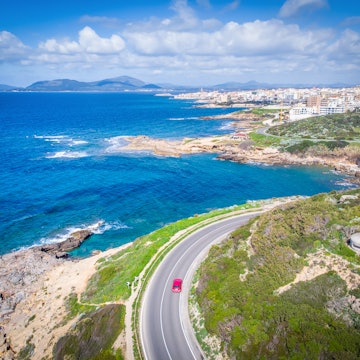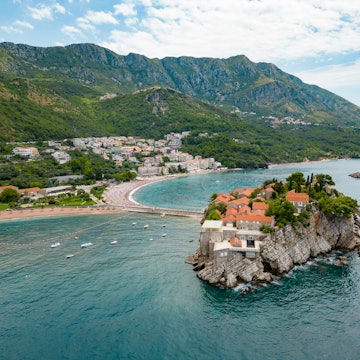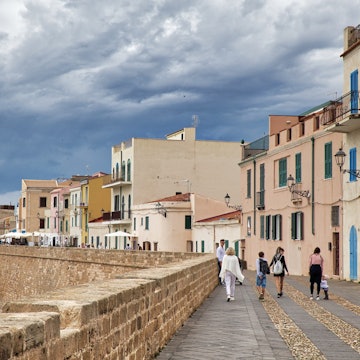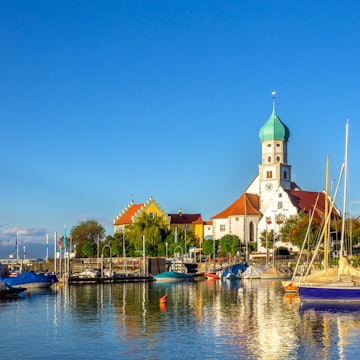

Corsica has many stunning beaches and we've got the perfect round up to help you choose © Dragosh Co / Getty Images
The French call Corsica L’Île de Beauté (the Isle of Beauty) for good reason: with 20 mountains topping 2000m the Mediterranean island combines dramatic mountain scenery with beautiful beaches, hidden coves, age-old stone villages, and vegetation that ranges from Alpine to dry Mediterranean.
The mountains dominate the island’s western and central regions and form the central bone of the long finger that juts north. As a result, some beaches in the west are inaccessible by road or require a 4WD with high clearance (your average urban SUV is no good here!) or a decent pair of hiking boots to reach.
Those along the much flatter east coast are easily accessible and more suitable if you're traveling with kids or anyone with mobility issues.
We’ve grouped our recommendations according to the island’s two regions: Haute-Corse (Upper Corsica which encompasses the north and the economic capital Bastia) and Corse-du-Sud (South Corsica which includes the administrative capital Ajaccio).
There is a stark contrast in beach facilities between the two regions – most in Haute-Corse are wild with no amenities at all. Come prepared: a parasol is mandatory as there is no natural shade and if there is, chances are someone will have found it before you! Bring water and check the weather before you set off – if the Mistral wind is blowing it will whip up the waves, particularly along the western coast, which could make swimming dangerous. Beaches in Corse-du-Sud, however, offer amenities and a host of nautical activities.
Regardless of which beach you choose, a visit during the height of summer means you’re unlikely to have it to yourself! And remember to bring cash – many of the car parks and restaurants don’t accept cards. With those practical tips in mind, here's our pick of the best beaches in Corsica.

Haute-Corse
1. Ostriconi
This 800m-long, white sandy beach lies between the Ostriconi river and the sea. It faces west, which means on days with strong swells it will be too dangerous to swim. But this is still the place to be for sensational sunsets that turn the rocks at the northern end of the beach red. On calm days, the vibe is very different – warm, still water that stays shallow for a long way out makes the sea here a wonderful natural paddling pool for kids.
Swimming is supervised in summer, but bring what you need as there are no amenities at all. Nudist bathers are tolerated at the northern end where there are a few rocks. The beach is a 5-minute walk from the free car park along a sandy path and over a wooden bridge – not ideal for pushchairs.
Planning tip: the Sentier des Douaniers (Customs officials' path) starts here heading east towards Saint Florent. It’s a two-day hike that will take you via Ghignu and Saleccia beaches.
2. Ghignu
Tucked away in the Agriates Desert region, this wild beach is far less crowded than the more popular Saleccia beach further along the coast, but they both share crystal-clear, turquoise waters and white sands. The only ways to reach it are either by boat or driving an off-road vehicle for 13km down an extremely bumpy track, making it a pretty well-kept secret. Bring plenty of water and a picnic, and admire the 400m stretch of sand from the top of the dune at its eastern end.
Planning tip: you can stay overnight in one of the restored paillers (where shepherds kept straw) which can sleep 4-6 people. There is no running water, electricity or mattresses but there are communal toilets. In winter you can just rock up and sleep here for free but it's on a first-come, first-served basis. In summer you need to reserve your spot in advance.
3. Arone
Set just south of the Calanques de Piana Unesco World Heritage Site, Arone is a lovely family friendly beach with easy access from the car park and a very gently sloping sea-bed, so the water is warm and shallow quite far out. The maquis-covered foothills of Monte Ravu slip gently into the sea on the southern end of the beach and the low-lying rocks at both ends are perfect for wannabe explorers of small marine life.
Swimming is supervised in summer. Three paillotes (beach huts) offer sun loungers, parasols, showers and casual eating. If you want a smarter alternative, then head to Le Casabianca seafood restaurant perched on low rocks at the western (right) end of the beach. It’s also a great place to watch the red and pink columns of the Calanques de Piana glow in the sunset.
Planning tip: Get here early if you’re visiting in the summer or you may find the free car park is full.

4. Calvi (aka La Pinède)
Calvi beach has an urban vibe, particularly during the week-long Calvi on the Rocks music festival held in early July when young Corsicans and tourists sway and pose in fashionable swim-wear on the beach and in the shallow sea water, often with a cool glass of something in hand, to the sounds of electro-dance music from 3pm until 4am daily.
The rest of the summer is a little calmer. Paillotes occupy the central section of what is one of the longest beaches in Corsica, boasting some of the softest sand. Add in the gentle slope to the water and you get the ideal beach for young children who can paddle and lick ice cream at the same time. For older ones willing to vanquish their fear of heights, there’s the Altore adventure climb through the pine trees about midway along the beach.
Sun loungers and parasols are available to rent and there are public showers, toilets, and a playground. Swimming is supervised in summer. Pick one of the many restaurants and sip a cocktail whilst you watch the sun sink behind Calvi citadel to the left of the beach, then turn your gaze inland and admire Corsica’s highest peak (2706m), Monte Cinto, one of the five peaks over 2000m that dominate Calvi Bay.
If you fancy a change of scenery, take the little train northwards to Ile Rousse to test some of the other beaches along the way or go diving at the foot of the citadel to see the wreck of a US Air Force bomber shot down in 1944.
5. Barcaggio
At the northern tip of Corsica on the Cap Corse, you may find you’re sharing beach space with a herd of cows. They look gentle but don’t try and get up close to take a picture – it annoys them. They will let you be if you leave them alone.
The beach is accessible on foot from the paying (€2) parking lot which is about 1km (0.6 miles) away. Or you can reach it by walking along the Sentier des Douaniers that runs along the coast (unsuitable for pushchairs and children under 8) from Macinaggio (2.5 hours) or the beach at Tamarone (almost 2 hours). There are one or two paillotes on the beach and restaurants in the nearby eponymous village.
Planning tip: Keep in mind that all the beaches on the Cap Corse tend to get invaded by seagrass meadows (Posidonia oceanica) after storms – these are the lungs of the Mediterranean Sea so they might not look or smell very nice, but are vital to the ecosystem. If you dig into them you’ll find all sorts of tiny sea creatures that fish and cows like to feed on.
Corse-du-Sud
6. Rondinara
A perfect, naturally formed scallop filled with shallow, glass-clear, turquoise water edged by white sand: no wonder this beach is regularly voted amongst the most beautiful in Europe! But its fame is becoming its undoing: from June to September the sand is very crowded and the many boats that anchor here churn up the sea bed and turn the water cloudy. If you can’t come out of season try coming very early in the morning or late in the afternoon when some of the old magic returns.
The only permanent building in sight is a restaurant set back from the beach amongst the trees. In the summer a paillote is set up next to the paying parking lot (€5/day, cash only). There’s a small nautical center from which you can rent parasols and sun loungers. Wild cows also like this beach, even at the height of summer, but don’t get too close to them. They are wild animals and don't appreciate close contact.
Planning tip: if the beach is too busy for your liking, head towards the left (southern) end of the beach where you’ll find a path. A 5-minute walk through the maquis will bring you to a crescent-shaped beach where the sand is a bit rougher and the sea isn't quite as calm but there are fewer people.

7. Palombaggia
Fine white sand, pink and grey granite rocks, umbrella pines (but too far back from the beach to provide much shade) and all this just 12km (7.4 miles) south of Porto Vecchio. The 1.5km (1 mile) long but very narrow beach is easy to access by car (parking is free) but also in the summer by shuttle bus from Porto Vecchio. The easy access means the beach is extremely popular in the summer but that’s also because swimming is supervised. The sea is generally calm and the slope into the water is gentle, making it ideal for people with accessibility issues and children. The tongue of flat pink rocks at the northeastern (left) end makes an ideal natural armchair in which to sit with your feet in the water and watch the snorkellers.
Unusually for a Corsican beach, there are public toilets. You can rent parasols and sun loungers from the beach restaurants and paillotes. There’s a diving club, a sailing club and a nautical club.
8. Santa Giulia
The south-facing beach, an easy 8km (5-mile) drive south from Porto Vecchio, is along a narrow strip of land with the sea to the east and a shallow lagoon to the west. It’s well protected from winds and the water is shallow quite far out – arrive early as young families will quickly crowd it at the height of summer.
There’ll be fewer people amongst the big, round, grey pebbles that emerge from the sea towards the left of the beach. These are lovely to snorkel through but the sea bed here is a bit pebbly so you might want to wear some water shoes. From here you can also smile at the antics of novice paddle-boarders and kayakers, and watch sailors hone their skills aboard small dinghies or catamarans.
Parasols and sun loungers can be rented from one of the restaurants and paillotes, also open in the evenings. Swimming is supervised in the summer. Cash only at the car park.
Planning tip: If you visit in the winter you may see a flock of pink flamingos in the lagoon.

9. Piantarella, Petit Spérone, Grand Spérone
If you’re into kite-surfing or wind-surfing, the northern end of Piantarella is the place to be. The beach is narrow and tends to get overcrowded, so walk south past the Roman ruins and along a 250m (820ft) path through vegetation. It will bring you to the Petit Spérone beach which, together with neighboring Grand Spérone beach, boasts some of the whitest sands in Corsica.
If there are still too many people here, head south and climb the steps cut into the rocks to reach the top of the corniche. Then turn west along a shady path through the golf course and 500m (1640ft) further along you’ll reach Grand Spérone beach which is far less crowded even in the middle of summer. There are no amenities at either of the Spérone beaches.
Planning tip: You’ll be facing due south with views of the Lavezzi islands – when the weather is clear you’ll be able to spot Sardinia.
10. Capo Di Feno
Another beach for big surf lovers! There are actually two beaches here separated by a field – Grand Capo is big enough to never seem crowded, and Petit Capo (aka Sevani) to the south is smaller and attracts fewer people. You’ll get shaken and stirred on the paved road to Grand Capo which forks near the coast. Both the dirt track on the left and the paved road to the right lead to the beach but there’s more (free) parking at the end of the dirt track. To reach Petit Capo just walk to the southern (left) end of Grand Capo and cross the field or splash through the rocks.
Swimming from either beach is dangerous when the surf is up. A lifeguard is on duty in July and August so keep an eye on the flag and don’t go into the water if the yellow or red one is hoisted. Parasols and sun loungers are available from paillotes.
At day’s end head over to the Grand Capo restaurant, Casa Nostra where you can sit with your feet in the sand, a cocktail in hand and feast your eyes on the changing colors of the sky as the sun sets and the last of the surfers ride the waves. On some summer evenings, there’s live music here too. Bring cash as the restaurant doesn’t accept cards.
Planning tip: If you walk to Petit Capo you’ll have to go past the nudist section at the far left of Grand Capo. If you'd prefer not to, you'll need to drive back up the D111B until you reach a turnoff pointing to Plage de Sevani. Drive through the housing development to reach the car park by the beach.















